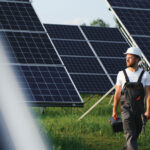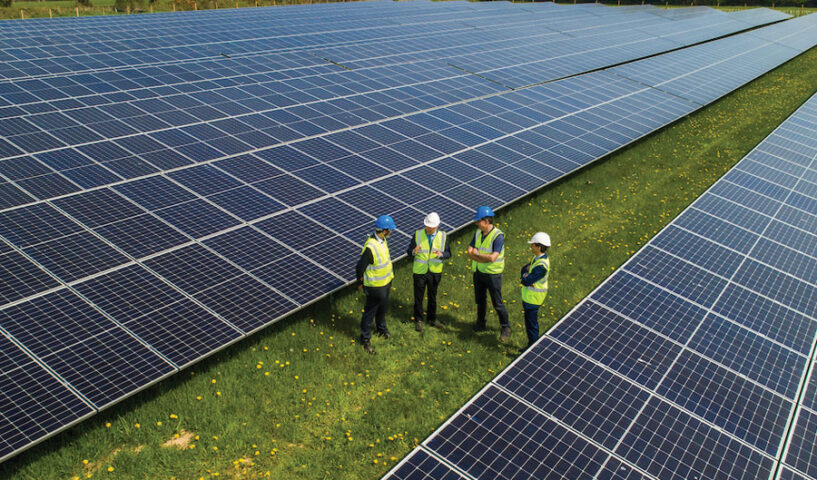
Challenges to accelerating the energy transition
4th October 2024
Meeting Ireland’s 2030 solar targets
4th October 2024Solar power: An unexpected champion in Ireland’s renewables mix

Solar power is fast becoming a central fixture in Ireland’s energy landscape – and a key pillar in ESB’s pathway to reaching net zero emissions by 2040.
If you had predicted 20 years ago that Ireland could source a large slice of its energy from sunshine, you might have been greeted with raised eyebrows (“here? With our weather…?”). And yet, this is exactly where we are today: solar power is fast becoming a crucial ingredient in our national electricity mix, complementing other renewables like wind.
In February 2024, ESB Networks announced that over 1GW (1,000MW) of solar is now connected to the Irish grid at utility scale and behind the meter – enough to power around 400,000 homes. Of this, approximately 300MW comes from domestic microgeneration, typically solar panels on household roofs. More than 100,000 of these rooftop microgenerators are currently hooked up to the network, with applications increasing 92 per cent year-on-year in 2023.
Why solar?
Solar offers a number of benefits in the Irish context. Firstly, it is highly cost-efficient. The cost to build and operate a solar farm has fallen significantly over the past decade, as technology has improved and become more readily available. This looks set to continue in the short- to medium-term: the International Energy Agency (IEA) is forecasting an underutilisation of solar panel production capacity leading up to 2030, and this excess supply will likely lead prices to fall further. This is good news for energy users, with the growth of solar set to place downward pressure on the wholesale cost of electricity.
Second, as with other renewable technologies, solar offers an opportunity for energy independence by replacing the volatility of fossil fuels sourced on international markets. This is particularly valuable for a country like Ireland, which has been so reliant on imported energy in the past.
A third crucial benefit is that solar is a good fit for the patterns of energy demand that are typical in our domestic market. Compared to other countries, we use far more electricity during the day than by night – and as solar operates only during daylight hours, it can deliver this necessary boost with very little wastage.
While there may be an assumption that Ireland’s generally grey skies are not conducive to solar energy, technological advances mean it is now possible to source PV panels designed specifically for the kind of mid-light seen on our island. And although these panels do not generate all of the time, they provide the ideal complement to wind energy: in the most simple terms – a sunny day is less likely to be windy and vice versa.
Powering our clean energy future
For all these reasons, solar power is a key pillar in ESB’s pathway to reaching net zero emissions by 2040, as the company’s generation business moves to progressively decarbonise the electricity it produces. It is set to deliver a further 2GW of solar in the coming years, equivalent to over one third of the country’s current peak electricity demand of 5.5GW. “We are targeting a 5GW renewable electricity portfolio by 2030, and solar will be a vital piece of that puzzle,” explains Eoin Naughton, Solar Development Manager at ESB. “Our total planned investment in solar projects runs to €1 billion, with construction due to commence on five projects over the next 12 months alone.”
One of these projects is the Middleton House Solar Farm in County Longford. The Lanesborough area where the site is located boasts a long history of electricity generation, making the build a prime example of old worlds meeting new. The solar farm will connect to the grid through a new cable route installed along a now defunct rail line, which until a few years ago had been used to transport peat to the former carbon-intensive Lough Ree Power Site.
“Solar is a good fit for the patterns of energy demand that are typical in our domestic market.”
By the time the project is complete, this route will be transporting up to 57MW of clean electricity with the capacity to power over 15,000 homes. New solar facilities like this one, the ESB site in Bullstown in County Meath, or the joint ESB-Bord na Móna farm planned for Timahoe, County Kildare, are maintaining and transforming the midlands’ crucial role as a strategic energy hub heading into Ireland’s clean energy future.
Communities and customers driving transformation
These utility-scale solar farms are major infrastructure projects, making close engagement with local communities essential to navigate challenges and unlock the benefits. For farmers, solar can provide valuable diversification opportunities while helping to bring down carbon emissions. Agricultural land used for solar farms can simultaneously enhance biodiversity, with a recent All-Island Pollinator Plan report highlighting the potential for these sites to support bees and other pollinators. Solar farms can also continue to be used for sheep grazing, providing a cost-effective approach to vegetation management. For the broader community, ESB offers benefit funds linked to solar sites like Lanesborough, which local groups can access to secure finance for projects that will make a difference to people living in the area.
Alongside the growth in domestic microgeneration, the rise of these new large-scale facilities signals that solar is becoming a permanent fixture in the Irish energy landscape. “There is clearly a huge appetite for zero-carbon energy on the part of consumers, and there is already a broad understanding of the role solar power will play in our future electricity system – not only as a low-cost energy source, but as a way for Ireland to move away from fossil fuels and become energy independent as part of a broader renewables-based system,” concludes Naughton.
Contact:
T: +353 1 676 5831
W: www.esb.ie


